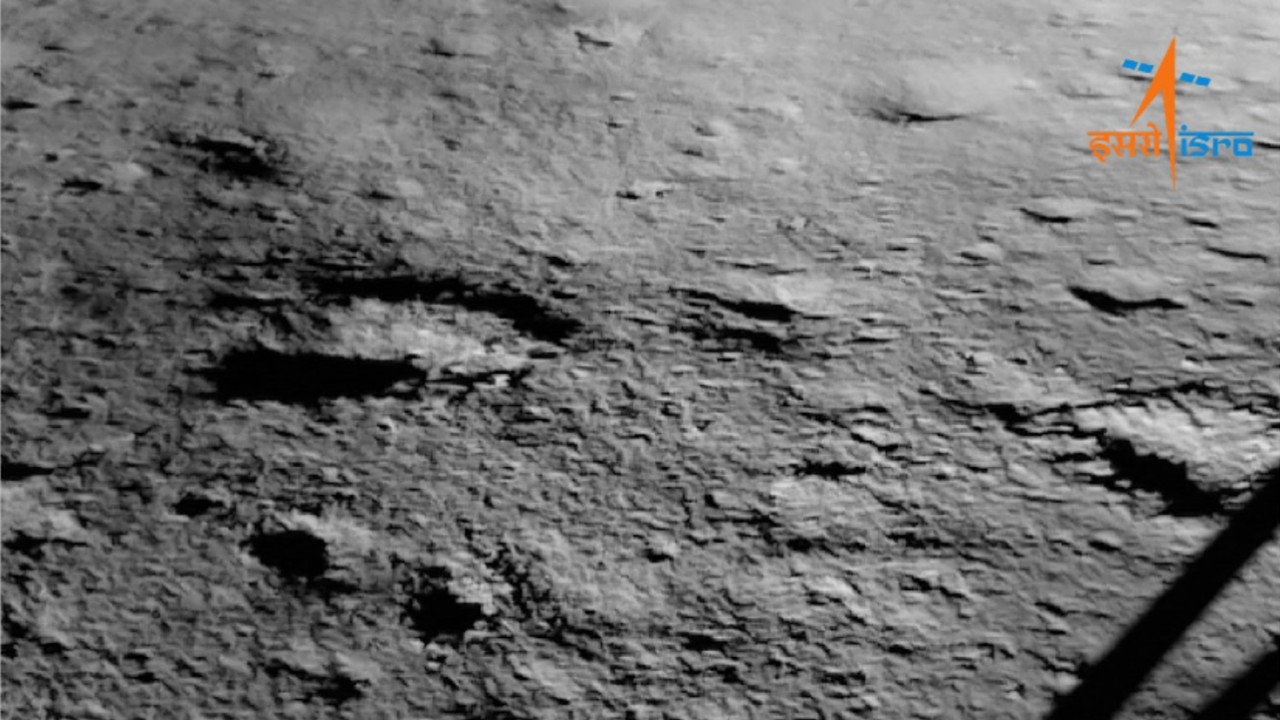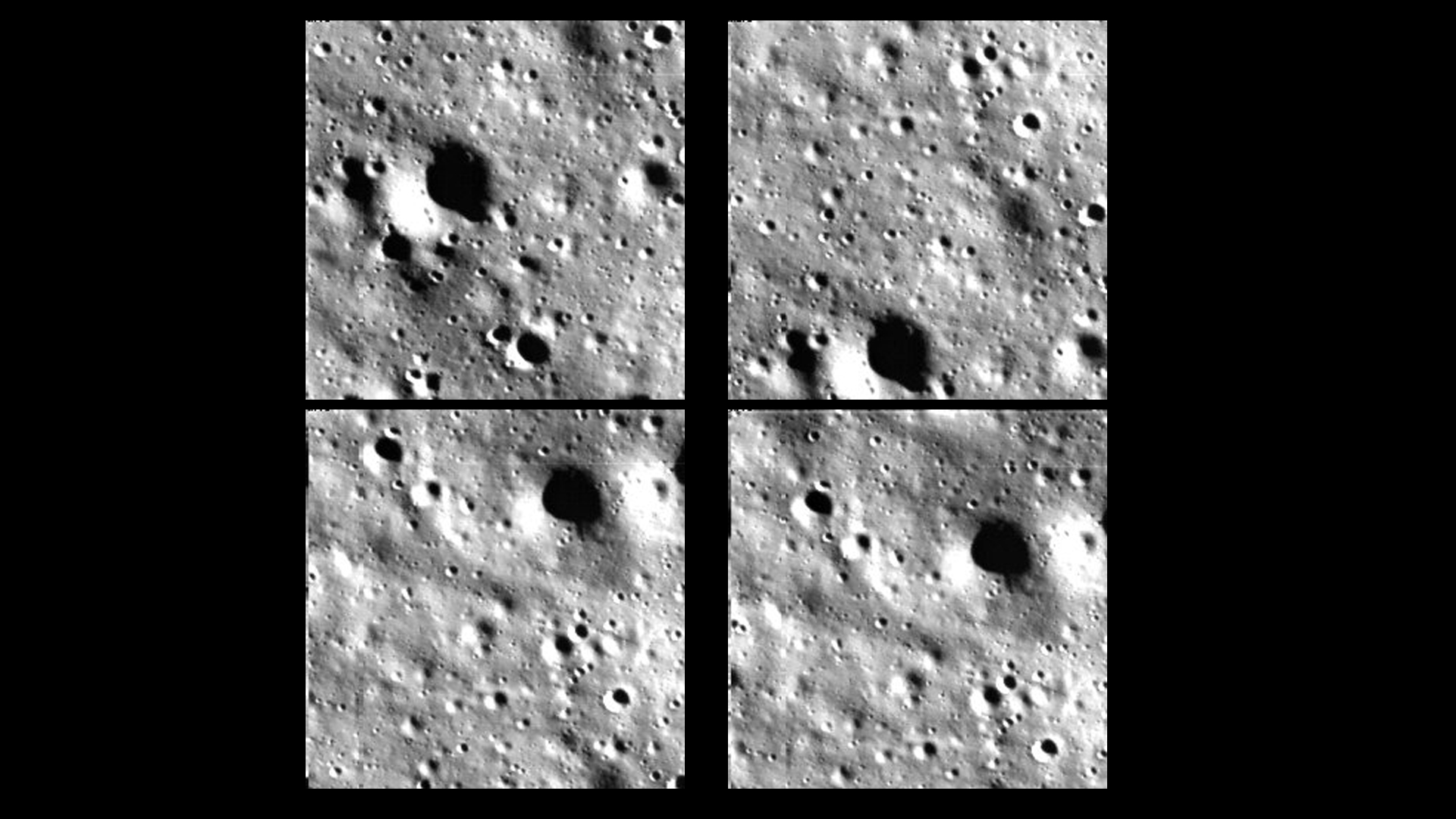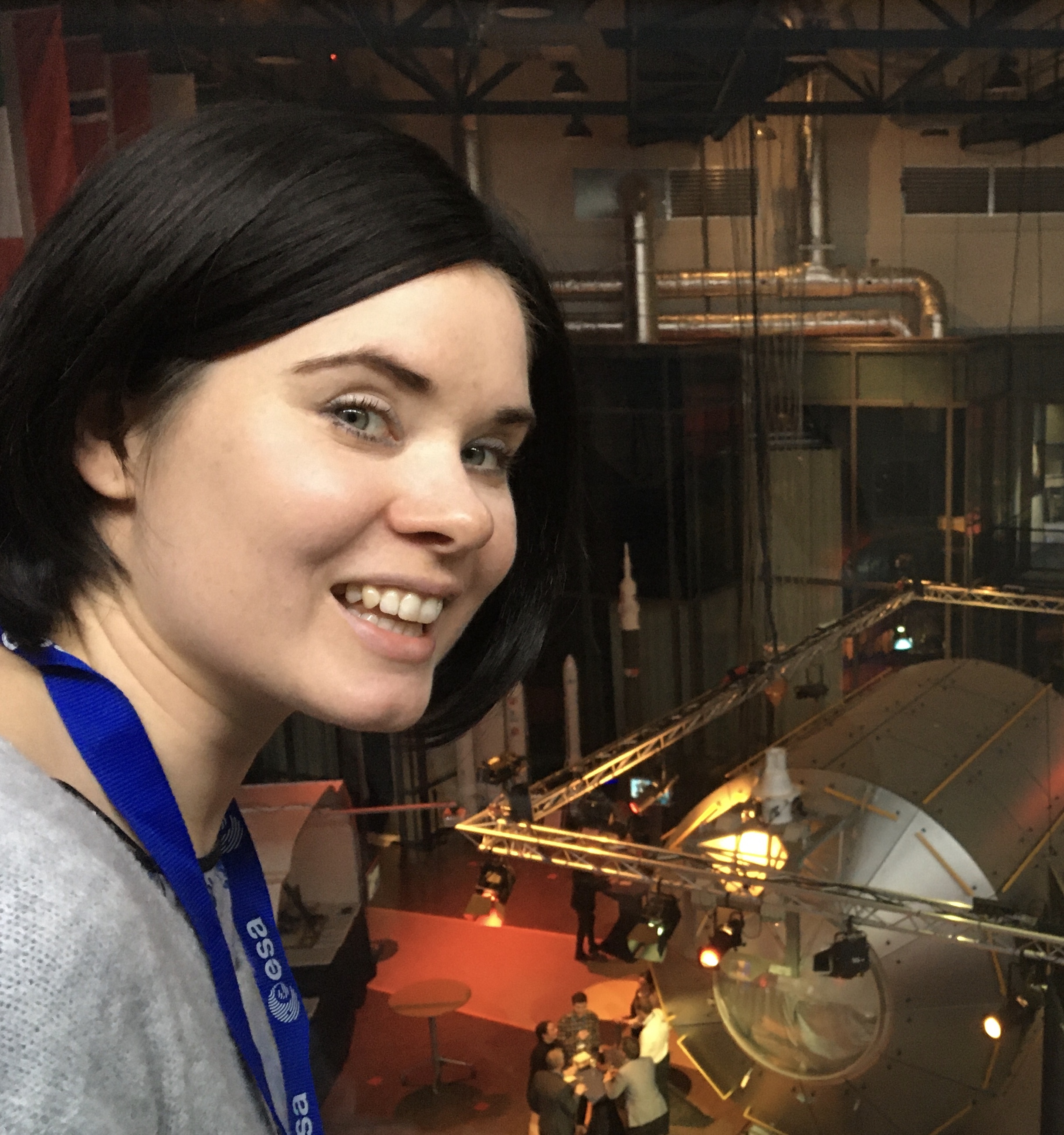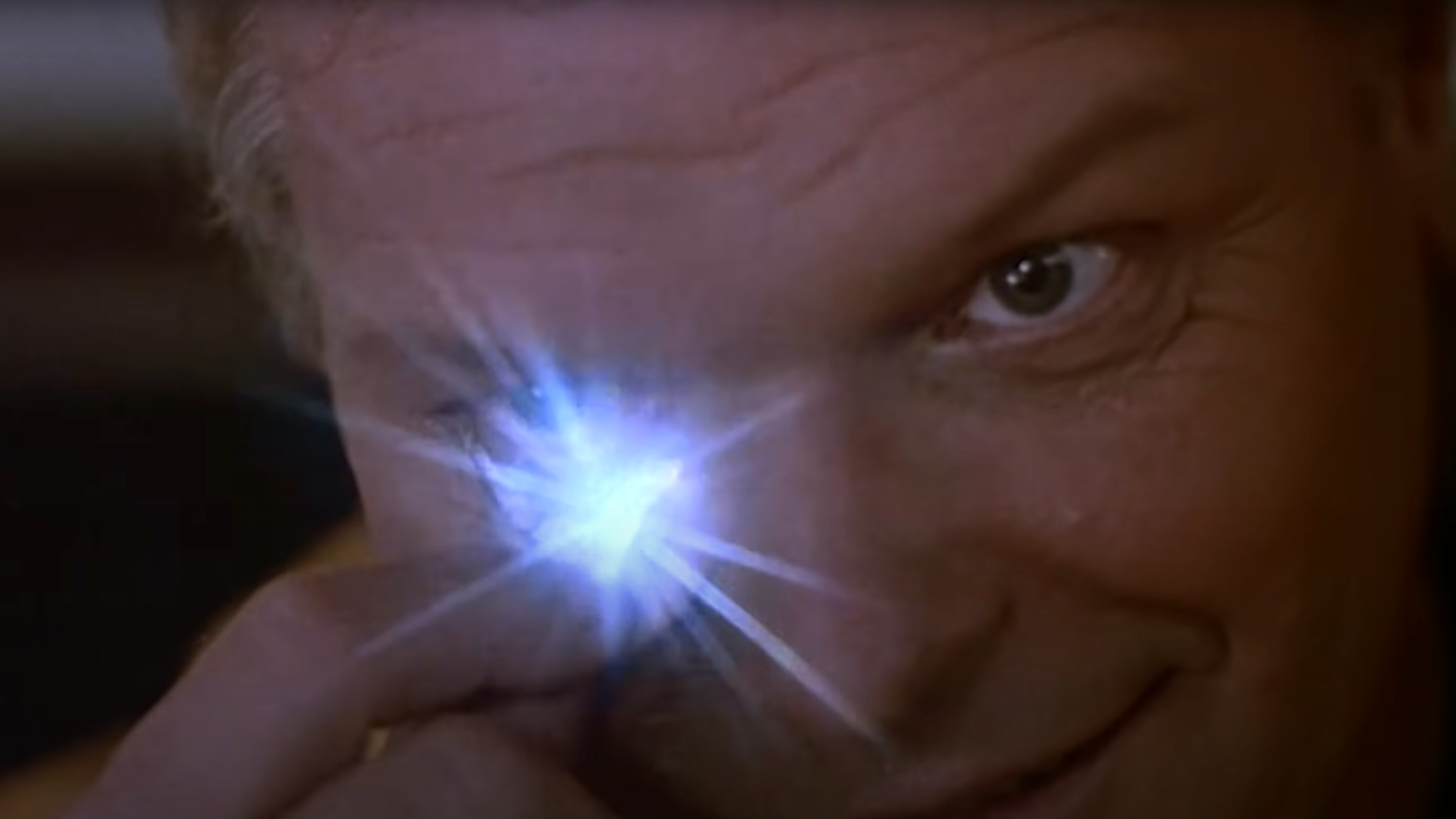See 1st photos of the moon's south pole by India's Chandrayaan-3 lunar lander
India's Chandrayan-3 mission has nailed its lunar landing.

The first images from India's Chandrayaan-3 mission taken after the probe's historic moon touchdown reveal a pockmarked surface near the lunar south pole.
The Indian Space Research Organisation (ISRO) shared the images on X, formerly Twitter, on Wednesday (Aug. 23), about four hours after the Chandrayaan-3 spacecraft completed its smooth descent.
The first set of four images were taken by the lander's Horizontal Velocity Camera as it was nearing the surface of the moon. An additional image from the Landing Imager Camera, shared a little later, shows a glimpse of the landing site, including a portion of the spacecraft's landing leg and its shadow.
"The communication link is established between the Ch-3 Lander and MOX-ISTRAC, Bengaluru," ISRO said in a post on X. "Chandrayaan-3 chose a relatively flat region on the lunar surface," the agency added in the subsequent post.
Related: India on the moon! Chandrayaan-3 becomes 1st probe to land near lunar south pole
The landing made India only the fourth country in history to successfully put a spacecraft on the surface of the moon, after the United States, the former Soviet Union and China. Chandrayaan-3 is also the first spacecraft in history to touch down near the lunar south pole, an area that is currently attracting the attention of scientists and space agencies from all over the world.
Scientists think that the permanently shadowed polar craters contain water ice trapped in the rocks, which could be extracted and used to support a permanent human presence on Earth's natural companion. Moreover, these lunar craters could be used to build next-generation telescopes that would allow astronomers to see farther than they can today.
Breaking space news, the latest updates on rocket launches, skywatching events and more!

A small rover called Pragyan arrived on board Chandrayaan-3 and will soon deploy and commence its exploration of the exciting region, so many more fascinating images are likely to come soon. Both the rover and the lander, however, are unlikely to remain operational for more than two weeks, as ISRO doesn't expect the vehicles' batteries to make it through the two-week lunar night.
Chandrayaan-3 was India's second try at landing near the moon's south pole. The country's first attempt at a lunar touchdown, in September 2019, failed when the Chandrayaan-2 lander crashed into the moon due to a software glitch.
India's triumph comes only three days after Russia lost its Luna-25 mission, its first attempt to put a spacecraft on the moon's surface in 47 years. Luna-25, too, was aiming for the lunar south pole, but crashed into the moon instead after a botched orbital maneuver on Saturday (Aug. 19).
Join our Space Forums to keep talking space on the latest missions, night sky and more! And if you have a news tip, correction or comment, let us know at: community@space.com.

Tereza is a London-based science and technology journalist, aspiring fiction writer and amateur gymnast. Originally from Prague, the Czech Republic, she spent the first seven years of her career working as a reporter, script-writer and presenter for various TV programmes of the Czech Public Service Television. She later took a career break to pursue further education and added a Master's in Science from the International Space University, France, to her Bachelor's in Journalism and Master's in Cultural Anthropology from Prague's Charles University. She worked as a reporter at the Engineering and Technology magazine, freelanced for a range of publications including Live Science, Space.com, Professional Engineering, Via Satellite and Space News and served as a maternity cover science editor at the European Space Agency.
-
DrRaviSharma Best Wishes for not only these but continuing images from Vikram lander and Pragyan rover.Reply
When I was working on the Apollo Program in 1969 we were in old video technology. The Lunar Lander had descent and ascent stages. The communications bandwidth was equivalent of 3kHZX6 6 voice telephone line of that time.
That is why you see TV streaks and poor quality Black and white images from 50+ year old technology.
Today Chandrayaan 3 fortunately is using best available space tested cameras and detectors and graphics processor hardware and software.
Hence the quality is very nice.
Going beyond, we expect as usual the scientific experiments value to improve namely spectrometry and other physical samples in-situ analysis.
If my Expert Voice on Space.com /india-moon-landing-not-a-failure.html] was heard we could also have hop and land capability which could grow to sample return to propulsion or orbiting platforms and or to Lunar Gateways as these mature as part of Artemis Accord. Further It is necessary to send RTG as then suggested 3 yrs ago to keep experiment investment alive for more than a Lunar daylight. from next mission on at least.
Again great start yet we (ISRO) need to receive samples as other 3 nations have done.
Thanks.
Ravi
(Dr. Ravi Sharma, Ph.D. USA)
NASA Apollo Achievement Award
Former MTS NASA HQ MSFEB
ISRO Distinguished Service Awards
Former Scientific Secretary ISRO HQ
Ontolog Board of Trustees
Particle and Space Physics
Senior Enterprise Architect -
billslugg Congratulations to India.Reply
Can anyone explain why the lander cannot survive two weeks of darkness? Why can't it simply "wake up" when the Sun comes back. -
DrRaviSharma Hi Billslugg! Greetings! and thanks for global sharing wishes :)Reply
I am not sure if electronic components are rated for lunar night temperature extremes. Industrial components can survive harsher than normal earth temperature ranges. But specially lunar nights can go down to 140 deg K, Lunar day is 400 deg K. Earth average is around 300 deg K.
That is why we use thermo-vac chambers and solar simulators to test and space qualify components.
The electronics is needed for transmission to receivers in orbit or antennas on earth and hence based on ALSEP Lunar Module Apollo experience in 1960's I had suggested Radio Isotope Thermal Generator (RTG) in 2020 which hopefully ISRO will also carry on future missions.
I had to help NASA Track the fall of such RTG in Mariana Trench in Pacific due to LEM reentering the atmosphere during Apollo 13 mishap. We 3 scientists were coordinating 60 global tracking observatories during 1968-1972.
Hope this info helps?
Regards,
Thanks.
Ravi
(Dr. Ravi Sharma, Ph.D. USA)
NASA Apollo Achievement Award
Former MTS NASA HQ MSFEB
ISRO Distinguished Service Awards
Former Scientific Secretary ISRO HQ
Ontolog Board of Trustees
Particle and Space Physics
Senior Enterprise Architect -
Starcrow Reply
Why did you suggest using RTGs, knowing the following?DrRaviSharma said:Hi Billslugg! Greetings! and thanks for global sharing wishes :)
I am not sure if electronic components are rated for lunar night temperature extremes. Industrial components can survive harsher than normal earth temperature ranges. But specially lunar nights can go down to 140 deg K, Lunar day is 400 deg K. Earth average is around 300 deg K.
That is why we use thermo-vac chambers and solar simulators to test and space qualify components.
The electronics is needed for transmission to receivers in orbit or antennas on earth and hence based on ALSEP Lunar Module Apollo experience in 1960's I had suggested Radio Isotope Thermal Generator (RTG) in 2020 which hopefully ISRO will also carry on future missions.
I had to help NASA Track the fall of such RTG in Mariana Trench in Pacific due to LEM reentering the atmosphere during Apollo 13 mishap. We 3 scientists were coordinating 60 global tracking observatories during 1968-1972.
Hope this info helps?
Regards,
Thanks.
Ravi
(Dr. Ravi Sharma, Ph.D. USA)
NASA Apollo Achievement Award
Former MTS NASA HQ MSFEB
ISRO Distinguished Service Awards
Former Scientific Secretary ISRO HQ
Ontolog Board of Trustees
Particle and Space Physics
Senior Enterprise Architect
"Radioisotope thermoelectric generators (RTGs) are the power plants of the interplanetary spacecraft. Or at least they have been for going on 50 years now. But they have significant drawbacks, the primary one being that they’re heavy. Even modern-day RTG designs run into the hundreds of kilograms, making them useful for large-scale missions like Perseverance but prohibitively large for any small-scale mission that wants to get to the outer planets. Solar sails aren’t much better, with a combined solar sail and battery system, like the one on Juno, coming in at more than twice the weight of a similarly powered RTG. To solve this problem, a group of engineers from the Aerospace Corporation and the US Department of Energy’s Oak Ridge National Lab came up with a way to take the underlying idea of an RTG and shrink it dramatically to the point where it could not potentially be used for much smaller missions." -
hasanwajid With its Chandrayaan-3 lunar mission, India's space agency, ISRO (Indian Space Research Organisation), has achieved history once more. The lunar lander has accomplished an extraordinary feat by taking and transmitting the first ever pictures of the mysterious and largely unexplored south pole of the moon. This historic occasion not only represents an important turning point in space exploration but also holds enormous promise for future lunar missions and scientific research.Reply
Exploring the South Pole of the Moon: Scientists and space agencies from all over the world have long been very interested in this region. Curiosity has been sparked by its unusual geography, which includes permanently shadowed craters that might contain water ice. Now that Chandrayaan-3 has successfully landed on the Moon's surface, the entire globe has the chance to investigate this mysterious region like never before.
Key Images Highlights:
Cratered Landscape: The Chandrayaan-3 photos show a harsh and craggy landscape covered in numerous impact craters of various sizes. These craters shed important light on the Moon's geological past and interactions with celestial bodies.
Permanent Shadow: The permanently shaded regions within craters are some of the most fascinating features captured in these photographs. Scientists are particularly interested in these places because it is thought that they contain water ice, which is essential for upcoming lunar missions and potential human habitation.
The photographs also provide glimpses of the lunar sunrise and sunset, illuminating the particular lighting conditions on the Moon. In addition to being stunning, these images also aid in the scientific understanding of the Moon's spinning features.
Scientific Potential: Chandrayaan-3's successful mission and image collection have created numerous chances for scientific investigation. Researchers can use the data to examine the Moon's geological history, resource potential, and contribution to our understanding of the history of the solar system as a whole.
Implications for Future Exploration: Chandrayaan-3's lunar lander's initial photographs represent a significant advancement in lunar exploration. They offer useful information for preparing further missions, such as the possibility of building a lunar outpost or more research into the Moon's potential as a stepping stone for more in-depth space exploration.
In conclusion, India's Chandrayaan-3 mission has made history by landing on the Moon and by providing humanity with its first images of the mysterious south pole. These pictures herald the start of a new phase in lunar exploration, igniting interest in science and the desire to colonize planets beyond Earth. Scientists and space organizations from around the world will no doubt find new mysteries hidden in the Moon's craters and shadows as they examine these photographs. -
Starcrow Reply
Yes, an obvious mistake at the UniverseToday.com website (in a report titled "India's Rover Rolls Out Onto the Lunar Surface" ). Thank you for pointing it out. It's such a recent matter that one can be sure that they haven't been able to shrink the hardware yet, and it might take them several years.StargazerUSA said:I'm positive you meant "where it could" -
Starcrow It's not that I'm slow but that it's no longer impossible to go online at home. Returning just to tell about the following mistake was an obligation. The passage was found at the said website but not in the report mentioned but in one titled "An Improved Radioisotope Thermoelectric Generator Could Dramatically Reduce The Weight Of Interplanetary Missions" (August 13).Reply
It's also Dr. Ravi Sharma's obligation to come back and explain about his suggestion. We need to know how the ISRO reacted to it. -
Starcrow Reply
...I meant "no longer possible". Wasn't there a time when one could do changes to one's comments?Starcrow said:It's not that I'm slow but that it's no longer impossible to go online at home. Returning just to tell about the following mistake was an obligation. The passage was found at the said website but not in the report mentioned but in one titled "An Improved Radioisotope Thermoelectric Generator Could Dramatically Reduce The Weight Of Interplanetary Missions" (August 13).
It's also Dr. Ravi Sharma's obligation to come back and explain about his suggestion. We need to know how the ISRO reacted to it.
